At a recent trip to the dermatologist, I asked if there was any treatment that could lighten the freckles I have dotting my face. Many of my formerly cute, small freckles are quickly becoming larger, unattractive splotches (a.k.a. "age spots") so I thought it would be better to nip them in the bud. (Of course, I could just buy a bejeweled elephant brooch to distract from them.) The experience jarred my memory of Lancôme releasing a "freckle pencil" many years ago that would allow one to paint one's face with as many specks as they wished. With that, I thought I'd look into the history of freckles from a beauty standpoint, starting in the 20th century, with an emphasis on the rise of creating faux freckles with makeup. I found that, much like Sgt. Pepper's Lonely Hearts Club Band, they've been going in and out of style (but they're guaranteed to raise a smile).
From the late 19th through the early 20th century, freckles were seen as unsightly blemishes that needed to be banished from the complexion, as demonstrated by this Pond's Vanishing Cream ad from1910.

(image from vintageadbrowser.com)
Some ads, like these for a potion known as Othine, were downright harsh – freckles are "homely" and shameful. These are from 1914 and 1928.
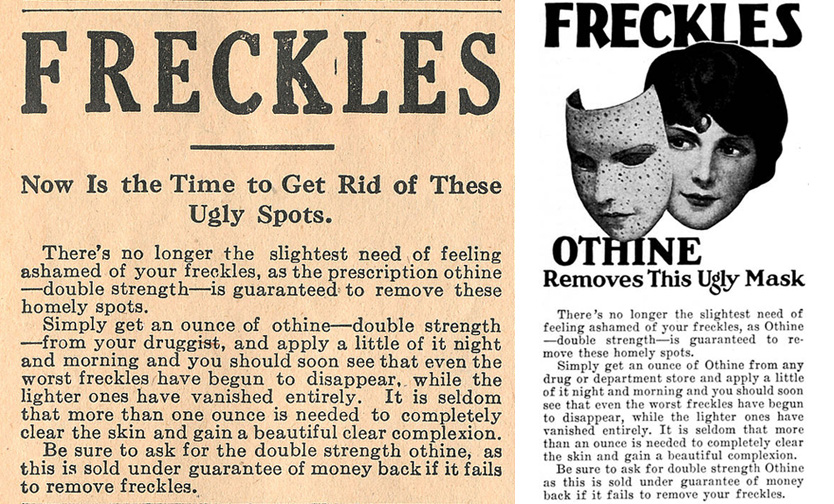
(images from flickr.com and cosmeticsandskin.com)
Perhaps the most well-known freckle antidote was Stillman's Freckle Cream. Below are ads from 1925 and 1934.
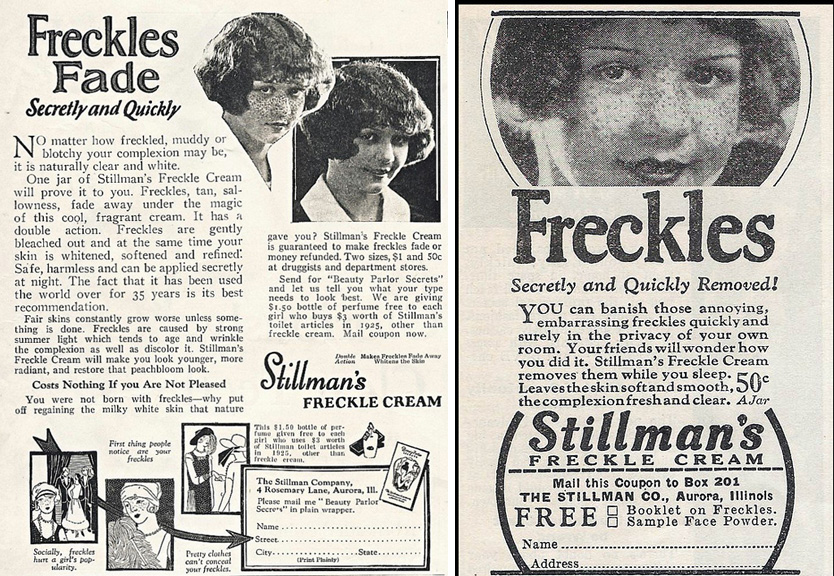
(images from tothetwenties.blogspot.com and flickr.com)
Stillman's continued selling their freckle cream throughout the 20th century and, oddly enough, the company exists today (although they mostly sell an alternative lightening cream to the Middle Eastern market). Here's an ad from 1956 and a picture of their contemporary freckle cream.

(images from cosmeticsandskin.com and facebook.com)
I can't explain exactly how or why a shift occurred in the perception of freckles, but somewhere in the mid to late 20th century they became acceptable and even desirable (see this article for possible reasons). Perhaps the rise of the tan's popularity was a factor – as early as the 1950s, tans correlated to health and a life of leisure, and a byproduct of spending quality time in the sun is the production of freckles. By the '90s, freckles were also linked to a more youthful appearance, an association that continues over 20 years later.
It seems that Chanel was the first company to market a product designed to create faux freckles. Released in 1995, Le Crayon Rousseur was "part of Chanel's effort to gain a high-fashion profile," according to Chanel's then market development manager Timothy Walcot, who added that "the `little girl' look is quite in. This is intended as a bit of fun." The instructions that came with the pencil recommended that it be used to "emphasize a light tan" as well.
Indeed, freckles quickly became a symbol of a carefree summer spent lounging under the sun's rays, as this Lancôme ad from 1995 can attest.
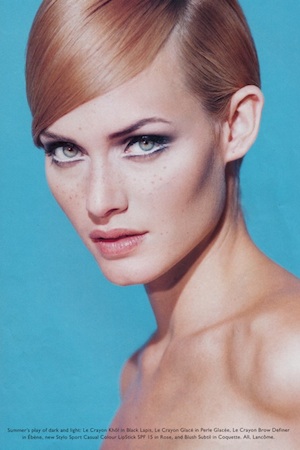
(image from style.com)
Lancôme followed in Chanel's footsteps 8 years later by releasing a Freckle Crayon as part of their summer 2003 collection. The mind behind the pencil, then artistic director Ross Burton, declared that "freckles are a symbol of freedom". Instead of trying to hide their spots with several inches of caked-on foundation, women were encouraged to "free" themselves from makeup and embrace their natural skin. And, of course, they were again associated with a summer vacation: "The natural, sun-kissed look is set to be big for spring/summer,'' stated a Lancome beauty counter rep. The company wasn't necessarily trailblazing – freckles had been "in" at least since 2001, when celebrities like Lucy Liu and top models Maggie Rizer and Devon Aoki proudly displayed their spots.
Sephora followed suit some time later, releasing a "My Lovelii Freckles" pencil as part of their now-defunct Piiink line. In the spring of 2009, makeup artist Charlotte Tilbury used a MAC lip pencil to draw dots on the models' faces for Matthew Williamson's spring 2009 runway show.
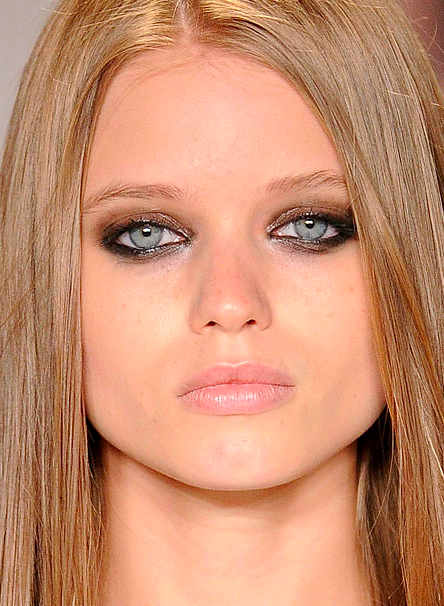
(image from style.com)
Each year since then, faux freckles made an appearance in at least one runway show. Let's take a look at some examples.
A model right before Rachel Comey's spring 2010 show:
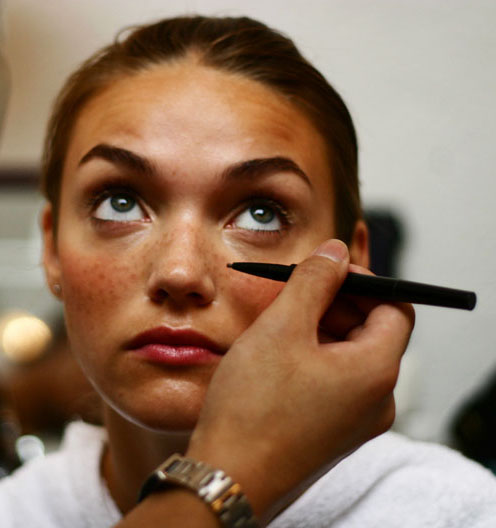
(image from lederniercri.it)
Chloe Fall 2011 (also by Charlotte Tilbury):
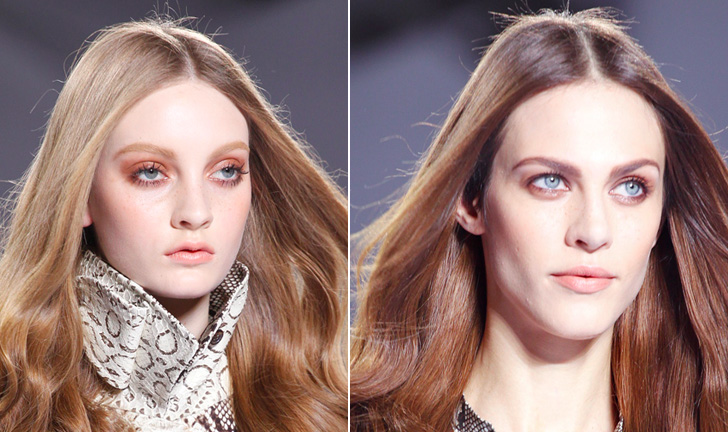
(images from style.com)
The trend grew by 2012, where faux freckles dotted the faces of models at the spring shows for Jeremy Scott, Dsquared, Emmanuel Ungaro, D&G, and Donna Karan.
Donna Karan, where Tilbury struck again.
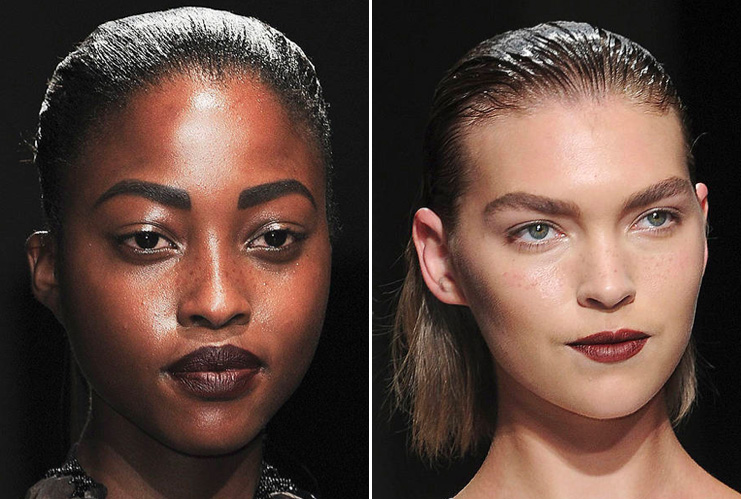
(images from elle.com)
Dsquared and Emmanuel Ungaro:
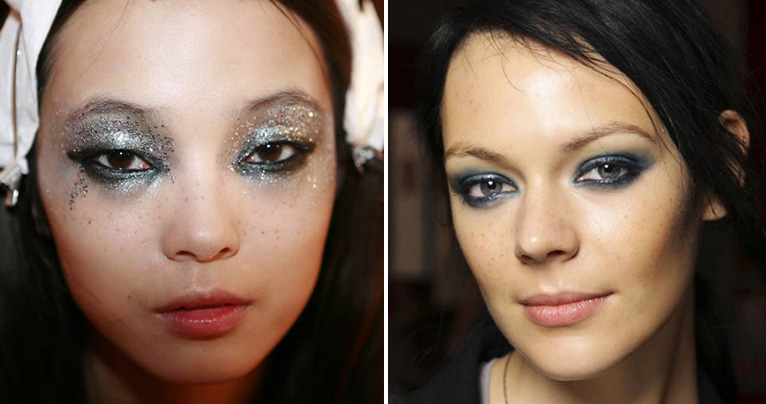
(images from makeupforlife.net and beautyeditor.ca)
Jeremy Scott:
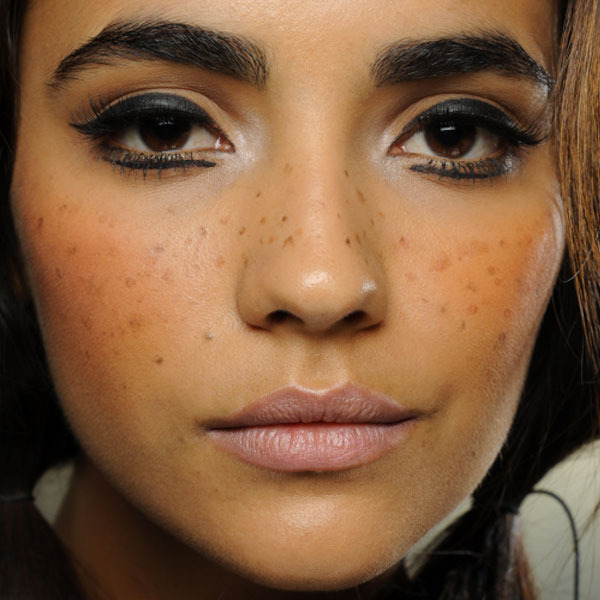
(image from beautylish.tumblr.com)
D&G:
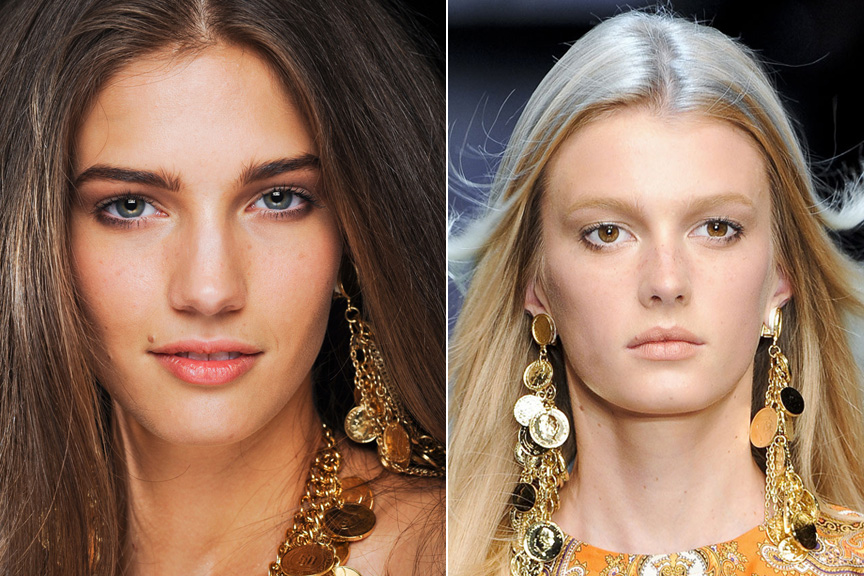
(images from foros.vogue.es)
By 2013, freckles had firmly established their role as an anti-aging strategy. "According to makeup pro Ruth Crilly, the easiest way to keep your youthful visage is to fake a few freckles," states an article at Refinery29. Adds Pixiwoo.com makeup artist Sam Chapman, "There’s something youthful and fresh about freckles." The spring 2013 shows further cemented the trend, with freckles proving especially popular at London Fashion Week (where, notably, Tilbury referred to the MAC pencil she uses to create the freckles as a "youth stick".)
Kinder Aggugini:
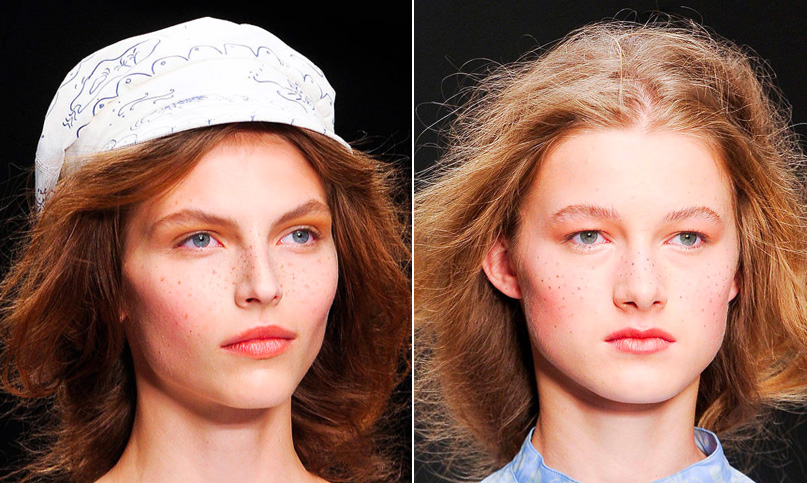
(images from elle.com)
Antonio Berardi (the makeup was done by Gucci Westman, who also allegedly painted on fake freckles for both Rag & Bone's spring 2012 and 2013 shows – however, the models' complexions looked totally clear in the pictures I found.)
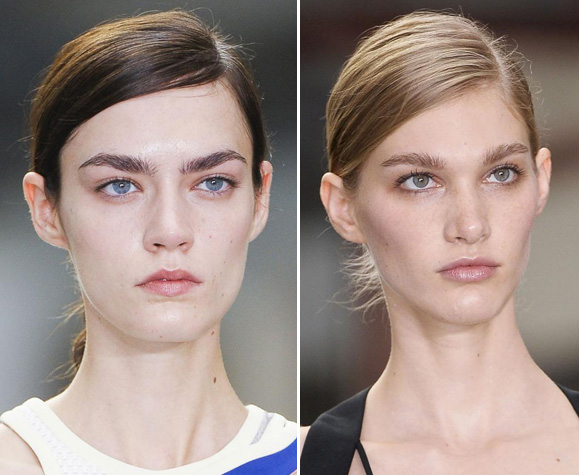
(images from fashionising.com)
Moschino Cheap and Chic:
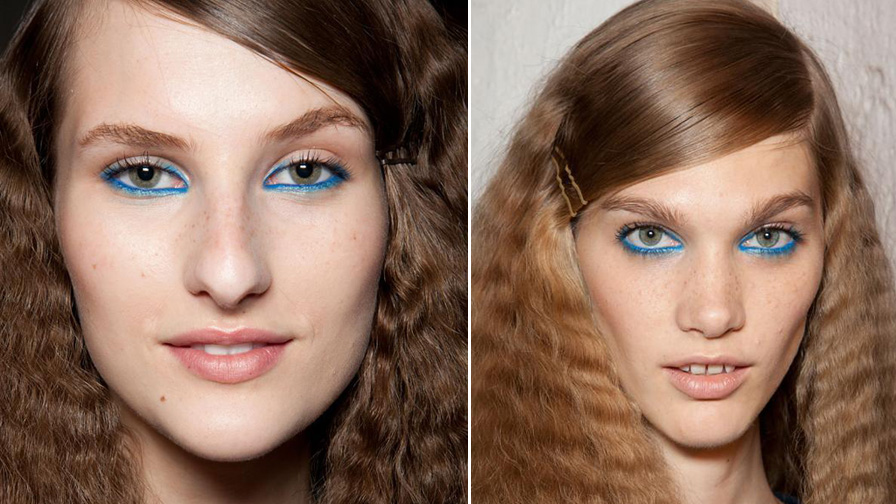
(images from fashionising.com)
Holly Fulton:
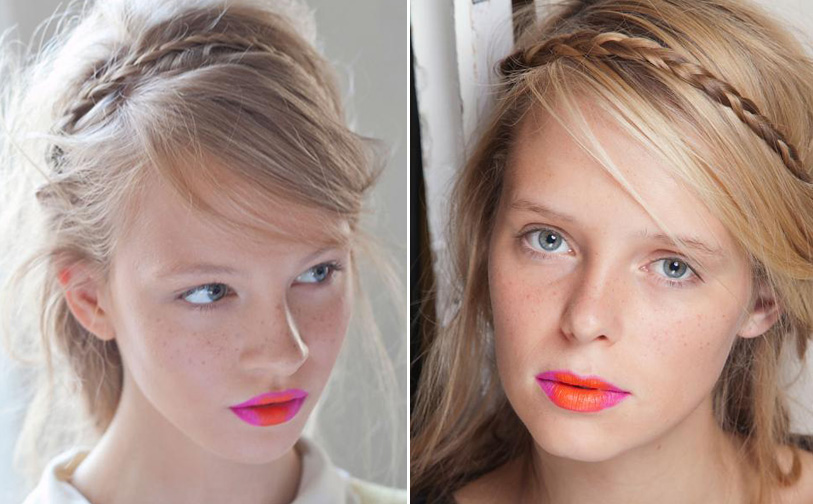
(images from makeupforlife.net and thelookbookphilosophy.com)
Pucci Fall 2013:
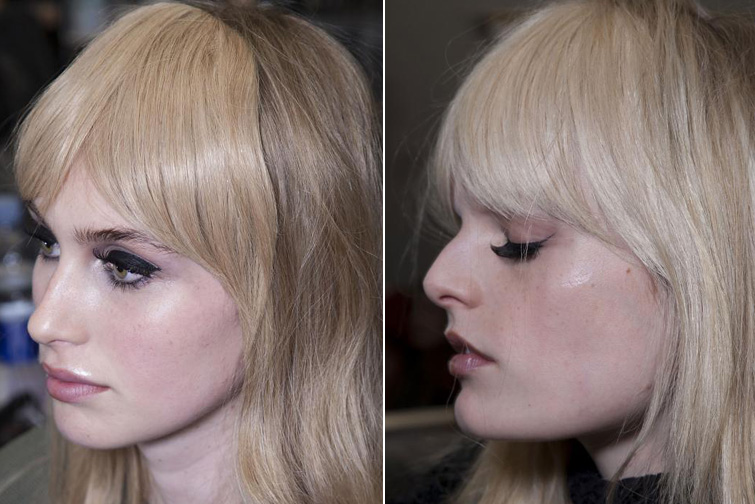
(images from fashionising.com)
Lisa Perry Fall 2013 – makeup by Westman (I'm beginning to think both she and Tilbury are a little obsessed with freckles!):
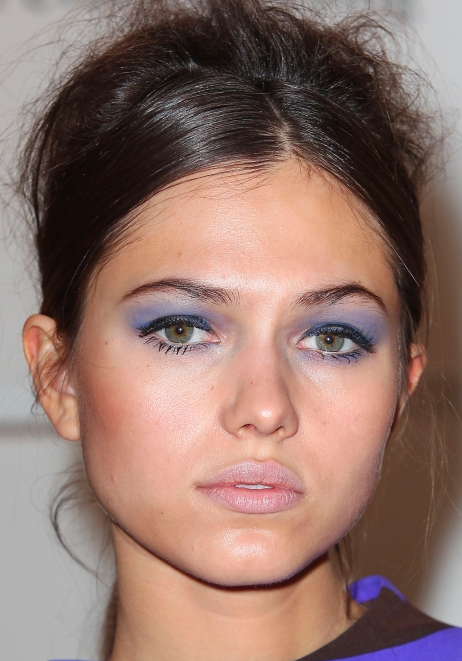
(image from socialvixen.com)
However, the addition of faux freckles isn't solely to give a youthful touch. At many shows, fake spots served an additional purpose: giving the overall look a retro twist. Tilbury cited the styles of Anita Pallenberg and Charlotte Rampling for the slightly '70s look she created at Chloe's fall 2011 show. For the 2012 D&G show, Pat McGrath said her inspiration came from a '60s style icon: "The look is all about the girls looking beautiful. We were looking at photos of Talitha Getty…the way she looks with the beautiful eyebrows and the freckles and fabulous eyes and we've done a very modern, fresh version of that." And MAC makeup artist Andrew Gallimore created a “cool California L.A. 50’s girl with a toasted tan, summer freckles, and a sunblock-neon lip” for Holly Fulton's spring 2013 show.
Meanwhile, Westman referred to several '90s types for her work at various spring 2013 shows. For Antonio Berardi, she says, "The Antonio Berardi girl is sporty, very clean and fresh…a girl reminiscent of a 90s Helmut Lang girl…we used Brown ColorStay Eyeliner to add freckles which gave the girls a youthful look." For Rag and Bone, she was inspired by "the iconic supermodels of the 90’s and the great structure of their brows." She adds, "I kept the makeup very pure, adding just a touch of natural flush to the lips by mixing two lip products together, and I used a brow pencil to create subtle freckles and a dramatic brow to top the whole look off.” Finally, for Lisa Perry, Westman went further back in time to the '60s: – "I focused on the eyes and went for something retro…I kept the skin simple and natural and created subtle freckles on the nose with a nude pencil."
Despite the popularity of freckles on the runway, there has been some ambivalence in the beauty community as to whether it translates to the real world. While in May 2013 Refinery29 was touting freckles' seemingly miraculous anti-aging properties, just a year and a half prior they were asking their readers whether they'd embrace the trend. The Gloss asked whether it was even appropriate to try to poach something that occurs naturally in many peoples' skin. Says the author, "This trend reminds me of my redheaded high school friend who despised bottle redheads, or my glasses-wearing friend’s rancor towards people who wore prescription-less glasses." As of spring 2013, The Gloss is definitively in the no-fake-freckle camp.
Additionally, the fact that makeup companies have not recently seized the opportunity to cash in and re-introduce freckle pencils might point to a dislike of, or perhaps disinterest in, the fake freckle trend. The lack of freckle pencils on the market could also be in part the result of Tilbury's and Westman's divulgence of the exact products they use to create a speckled effect, which already exist – it would be difficult to convince people to buy a new, specialized product when they can already buy something that would give the same look. Similarly, there's a wealth of tutorials on how to draw fake freckles using a variety of products, from eyebrow pencils to self-tanner painted on with a tiny brush.
My final thoughts: Personally, I'm indifferent to natural freckles. Some people have them, some don't, and I don't think people are more or less attractive because of them. I never really noticed mine, even, until Lancôme came out with that pencil! Now that they're getting bigger and starting to take over my face due to ever-advancing age, I'm more aware of them, but overall they're just another part of one's face. My indifference to real freckles means that I do find it strange that people would want to fake them, as I don't see them as a beauty trend one way or the other. They just…exist. Still, the makeup junkie in me can understand fake freckles – theoretically, it's not really much different than partaking in other makeup application. Why does anyone wear blue eyeshadow or paint their nails?
What do you think of both naturally-occuring freckles and the drawn-on ones seen on the runways? And what do you think caused the shift in the past 100 years from their perception as ugly blemishes to indicators of youth? Have you ever or would you paint on some fake specks?

